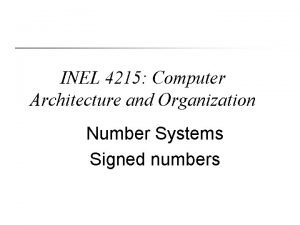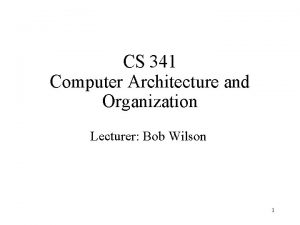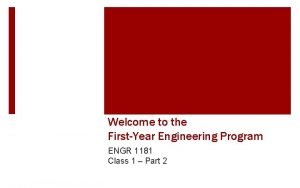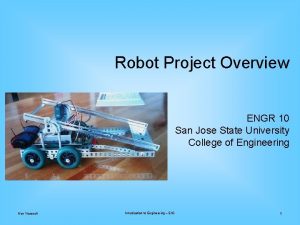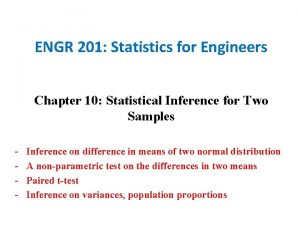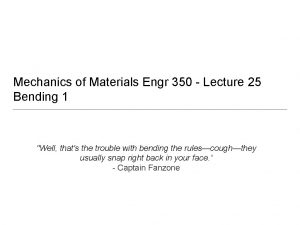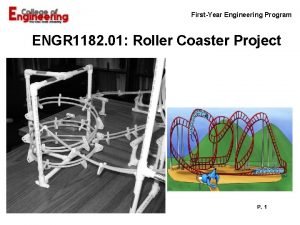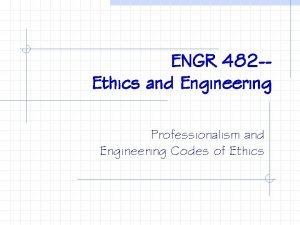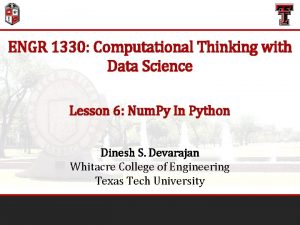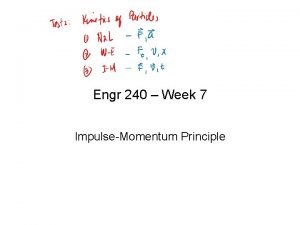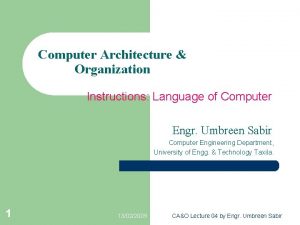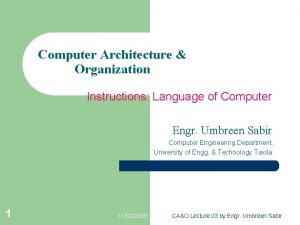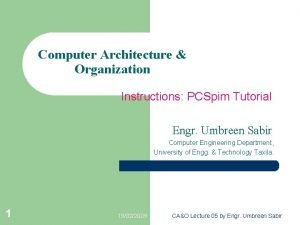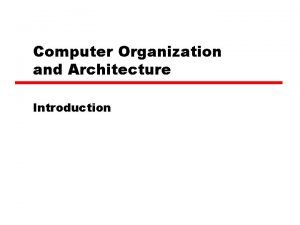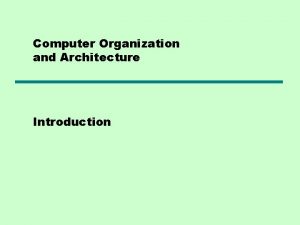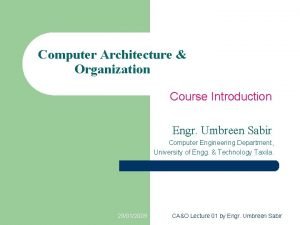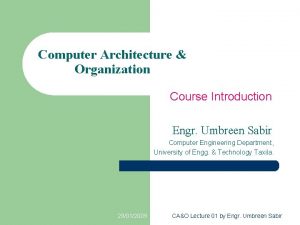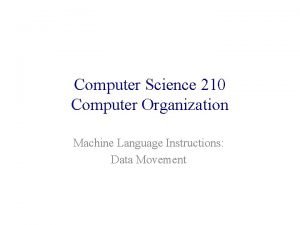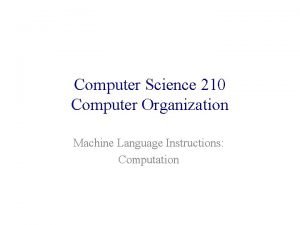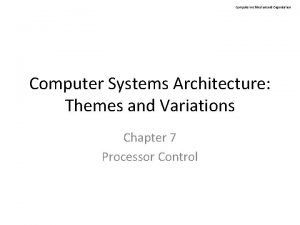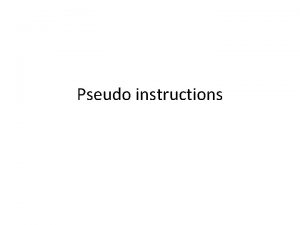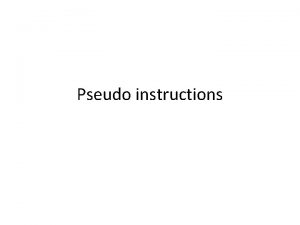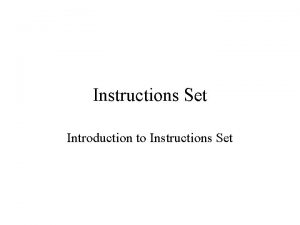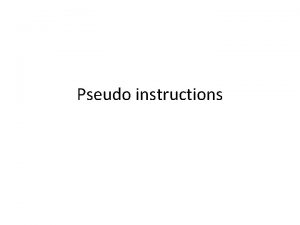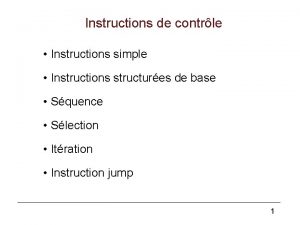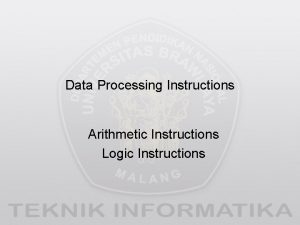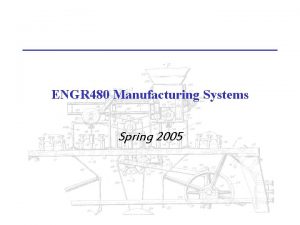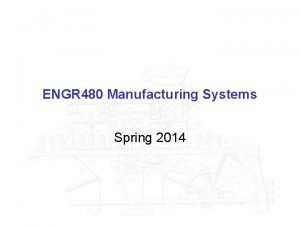Computer Architecture Organization Instructions Language of Computer Engr






















![Example # 6 l Convert in machine language. – – 23 A[300] = h Example # 6 l Convert in machine language. – – 23 A[300] = h](https://slidetodoc.com/presentation_image/aa2f992e7b1dac143fa216b2d5064402/image-23.jpg)



- Slides: 26

Computer Architecture & Organization Instructions: Language of Computer Engr. Umbreen Sabir Computer Engineering Department, University of Engg. & Technology Taxila. 1 30/01/2009 CA&O Lecture 02 by Engr. Umbreen Sabir

Introduction l Instructions: – l Instruction Set: – l The vocabulary of commands understood by a given architecture. Stored Program Concept: – 2 The words of a computer language. The idea that instructions and data of many types can be stored in memory as numbers, leading to the stored program computer. 30/01/2009 CA&O Lecture 02 by Engr. Umbreen Sabir

Operations of Computer Hardware l l Every computer must be able to perform arithmetic. MIPS assembly language notation – – l l Notation is rigid. Every instruction must follow this format. To perform operation. – – 3 add a, b, c Add two variables b and c and put sum in a. a=b+c+d+e add a, b, c # The sum of b & c is placed in a. add a, a, d # The sum of b, c & d is now in a. add a, a, e # The sum of b, c, d & e is now in a. 30/01/2009 CA&O Lecture 02 by Engr. Umbreen Sabir

Operations of Computer Hardware l # indicates comments. – l l l Every instruction should have three operands. Hardware for variable number of operands is more complicated. Design principle # 1: – 4 Comments always terminate at the end of line. Simplicity favors regularity. 30/01/2009 CA&O Lecture 02 by Engr. Umbreen Sabir

Example # 1 l C statements are: – – l l Translation from C to MIPS assembly is performed by compiler. Assembly code will be: – – 5 a= b + c d= a - e add a, b, c sub d, a, e 30/01/2009 CA&O Lecture 02 by Engr. Umbreen Sabir

Example # 2 l C statement is: – l Assembly code will be: – – – 6 f = (g + h) + (I + j) add t 0, g, h add t 1, I, j sub f, t 0, t 1 30/01/2009 CA&O Lecture 02 by Engr. Umbreen Sabir

Operands of Computer Hardware l l Operands are restricted and must come from registers. Registers: – l l MIPS registers are 32 32 -bit. Design principle # 2: – 7 Primitives used in hardware design that are also visible to the programmer. Smaller is faster. 30/01/2009 CA&O Lecture 02 by Engr. Umbreen Sabir

MIPS Register File l Holds thirty-two 32 bit registers – – Two read ports and One write port Register File 32 bits src 1 addr src 2 addr dst addr write data 5 32 src 1 data 5 5 32 32 locations 32 src 2 data write control 8 30/01/2009 CA&O Lecture 02 by Engr. Umbreen Sabir

Operands of Computer Hardware l l l Large no. of registers will increase clock cycle time. MIPS instruction is 32 -bit long. In MIPS, register notation is: – – – 9 Two character name followed by a dollar sign. $s 1, $s 2, …. . For register that correspond to C and Java variables. $t 0, $t 1, …. For temporary registers. 30/01/2009 CA&O Lecture 02 by Engr. Umbreen Sabir

Example # 3 l C statement is: – l l Variables f, g, h, I and j are in registers $t 0, $s 1, $s 2, $s 3 and $s 4 respectively. Assembly code will be: – – – 10 f = (g + h) + (I + j) add $t 0, $s 1, $s 2 add $t 1, $s 3, $s 4 sub $s 0, $t 1 30/01/2009 CA&O Lecture 02 by Engr. Umbreen Sabir

Memory Operands l l l Processor can keep small amount of data in registers. For arrays and structures memory is used. Arithmetic operations occur only on registers. So data transfer instructions are used. Data transfer instructions are: – – 11 Load -> copies data from memory to registers. Store-> stores data from register to memory. Format-> name of operation followed by register to be loaded/stored, then a constant and register used to access memory. Sum of constant and contents of second register gives memory address. 30/01/2009 CA&O Lecture 02 by Engr. Umbreen Sabir

Example # 4 l C statement is: – l l l Base address of array A is in $s 3. So the address is $s 3 + number to select element 8. Constant is offset & register is base address. Assembly code will be: – – 12 g = h + A[8] lw $t 0, 8($s 3) add $s 1, $s 2, $t 0 30/01/2009 CA&O Lecture 02 by Engr. Umbreen Sabir

Load Instruction op rs rt 16 bit offset Memory 2410 + $s 2 = 0 xf f f f 0 x 120040 ac $t 0. . . 0001 1000 +. . . 1001 0100 $s 2. . . 1010 1100 = 0 x 120040 ac 0 x 12004094 data 13 30/01/2009 0 x 0000000 c 0 x 00000008 0 x 00000004 0 x 0000 word address (hex) CA&O Lecture 02 by Engr. Umbreen Sabir

Memory Operands l Since 8 -bit bytes are so useful, most architectures address individual bytes in memory – l The memory address of a word must be a multiple of 4 (alignment restriction) Big Endian: leftmost byte is word address IBM 360/370, Motorola 68 k, MIPS, Sparc, HP PA l Little Endian: rightmost byte is word address Intel 80 x 86, DEC Vax, DEC Alpha (Windows NT) l 14 Alignment restriction-> Words must start at addresses that are multiples of 4. 30/01/2009 CA&O Lecture 02 by Engr. Umbreen Sabir

Memory Operands l l l Byte addressing affect array index. Offset added to $s 3 in previous example will be 4*8, or 32. Process of putting less commonly used variables in memory is called spilling registers. little endian byte 0 3 2 1 0 msb 15 lsb 0 big endian byte 0 30/01/2009 1 2 3 CA&O Lecture 02 by Engr. Umbreen Sabir

Example # 5 l C statement is: – l l Base address of array A is in $s 3. Assembly code will be: – – – 16 A[12]= h + A[8] lw $t 0, 32($s 3) add $t 0, $s 2, $t 0 sw $t 0 48($s 3) 30/01/2009 CA&O Lecture 02 by Engr. Umbreen Sabir

Constant or Immediate Operands l l Constants are used in instructions for certain operations. E. g. to increment an index. Add instruction with constant is: – l Design principle # 3 – 17 addi $s 3, 4 # s 3= s 3 + 4 Make the common case fast. 30/01/2009 CA&O Lecture 02 by Engr. Umbreen Sabir

MIPS Immediate Instructions l l Small constants are used often in typical code Possible approaches? – – – 18 put “typical constants” in memory and load them create hard-wired registers (like $zero) for constants like 1 have special instructions that contain constants ! 30/01/2009 CA&O Lecture 02 by Engr. Umbreen Sabir

MIPS Immediate Instructions addi $sp, 4 #$sp = $sp + 4 slti $t 0, $s 2, 15#$t 0 = 1 if $s 2<15 l Machine format (I format): op l rt 16 bit immediate I format The constant is kept inside the instruction itself! – 19 rs Immediate format limits values to the range +215– 1 to -215 30/01/2009 CA&O Lecture 02 by Engr. Umbreen Sabir

MIPS Register Convention 20 30/01/2009 CA&O Lecture 02 by Engr. Umbreen Sabir

MIPS Instruction Format OP 21 rs rt rd shamt funct l Op-> 6 -bits opcode that specifies the operation l rs-> 5 -bits register address of 1 st source operand l rt-> 5 -bits register address of second source operand l Rd-> 5 -bits register file address of the result’s destination l Shamt-> 5 -bits shift amount (for shift instructions) l Funct-> 6 -bits function code. 30/01/2009 CA&O Lecture 02 by Engr. Umbreen Sabir

MIPS Instruction Format 3 Instruction Formats: all 32 bits wide OP rs rt OP l sa funct immediate R format I format J format jump target Design principle # 4 – 22 rd Good design demands good compromises. 30/01/2009 CA&O Lecture 02 by Engr. Umbreen Sabir
![Example 6 l Convert in machine language 23 A300 h Example # 6 l Convert in machine language. – – 23 A[300] = h](https://slidetodoc.com/presentation_image/aa2f992e7b1dac143fa216b2d5064402/image-23.jpg)
Example # 6 l Convert in machine language. – – 23 A[300] = h + A[300]. Lw $t 0, 1200($t 1) Lw $t 0, $s 2, $t 0 Sw $t 0, 1200($t 1). 30/01/2009 CA&O Lecture 02 by Engr. Umbreen Sabir

Loading and Storing Bytes l MIPS provides special instructions to move bytes – – Lb $t 0, 1($s 3) #load byte 4 m memory Sb $t 0, 6($s 3) #store byte to memory load byte places the byte from memory in the rightmost 8 bits of the destination register store byte takes the byte from the rightmost 8 bits of a register and writes it to a byte in memory - what happens to the other bits in the memory word? 24 30/01/2009 CA&O Lecture 02 by Engr. Umbreen Sabir

Logical Operations l Shift left-> sll – l l 25 Shifting left by ‘i’ bits gives same result as by multiplying by 2 i Shift right-> srl Bit-by-bit AND-> and, andi Bit-by-bit OR-> or, ori Bit-by-bit NOT nor 30/01/2009 CA&O Lecture 02 by Engr. Umbreen Sabir

Next Lecture and Reminders l Next lecture – MIPS ISA Review l 26 Reading assignment – Chapter 2 30/01/2009 CA&O Lecture 02 by Engr. Umbreen Sabir
 Difference between architecture and organisation
Difference between architecture and organisation Pseudoinstructions
Pseudoinstructions Process organization in computer organization
Process organization in computer organization Instructions language of the computer
Instructions language of the computer Computer organization and architecture 10th solution
Computer organization and architecture 10th solution Virtual lab for computer organization and architecture
Virtual lab for computer organization and architecture Introduction to computer organization and architecture
Introduction to computer organization and architecture Bus architecture in computer organization
Bus architecture in computer organization Computer organization & architecture: themes and variations
Computer organization & architecture: themes and variations Computer organization and architecture 10th edition
Computer organization and architecture 10th edition Computer organization and architecture stallings
Computer organization and architecture stallings Computer organization and architecture definition
Computer organization and architecture definition 1 s complement
1 s complement Computer architecture and organization
Computer architecture and organization Instruction set architecture in computer organization
Instruction set architecture in computer organization Memory organisation in computer architecture
Memory organisation in computer architecture Engr 1181 osu
Engr 1181 osu Sjsu engr 10
Sjsu engr 10 Engr 201
Engr 201 Engr 1182
Engr 1182 Mechanics of materials
Mechanics of materials Performance task: roller coaster design
Performance task: roller coaster design Engr 482
Engr 482 Engr 1330
Engr 1330 Engr 1330
Engr 1330 Engr 112
Engr 112 Engr 240
Engr 240












